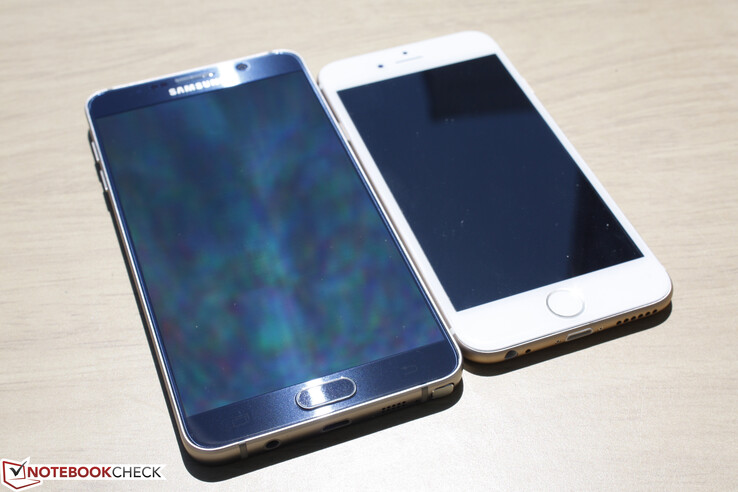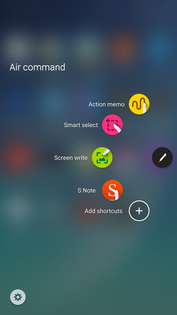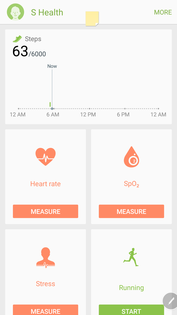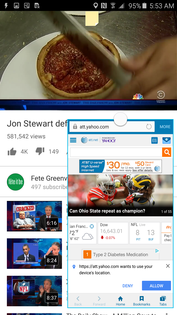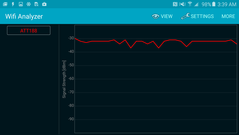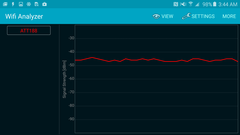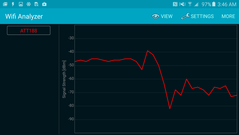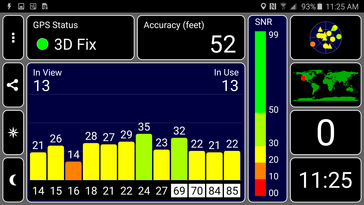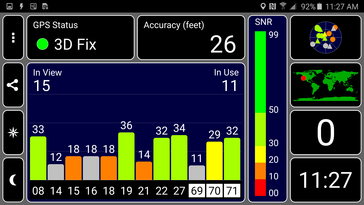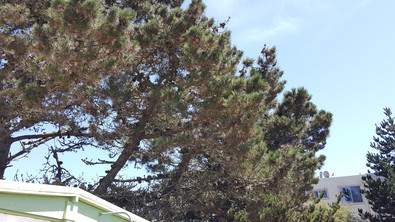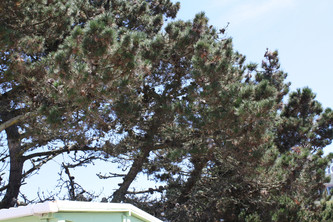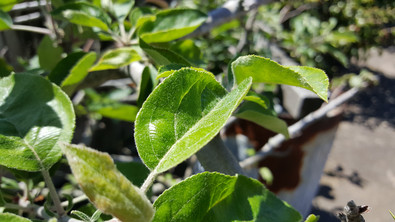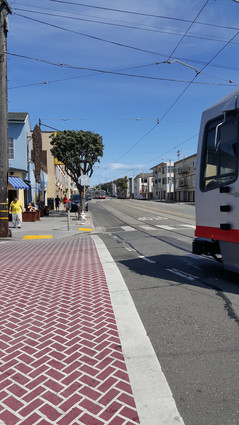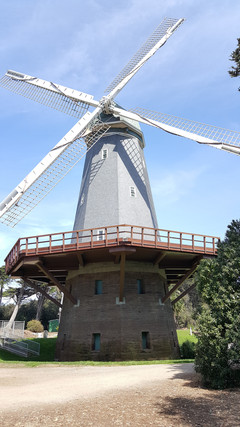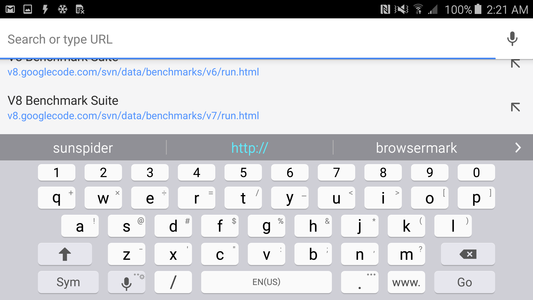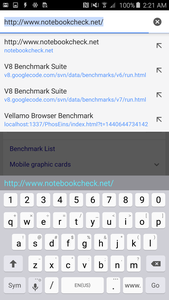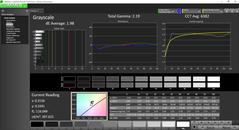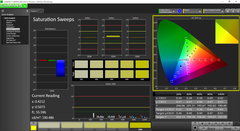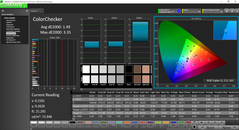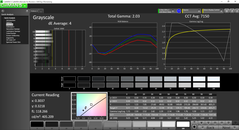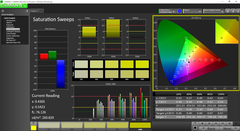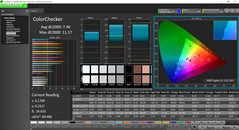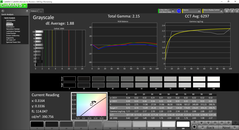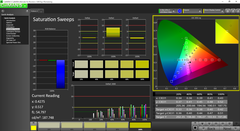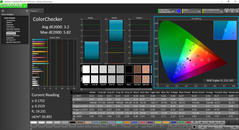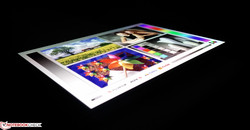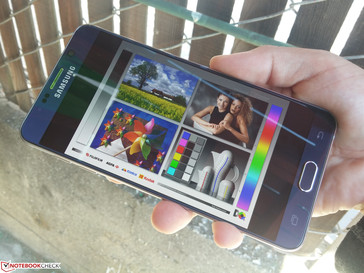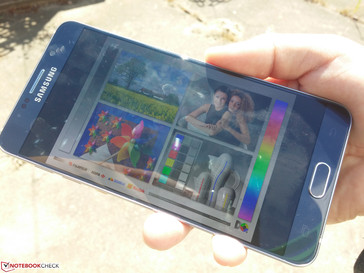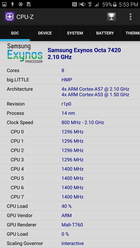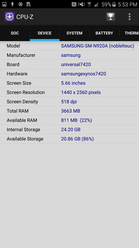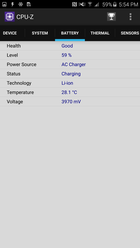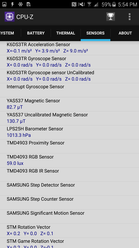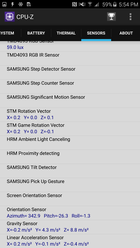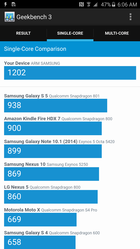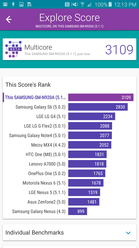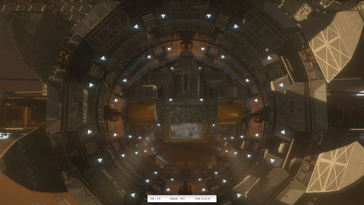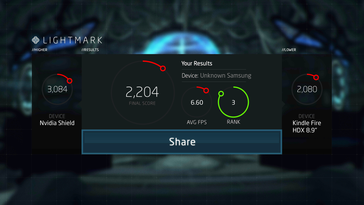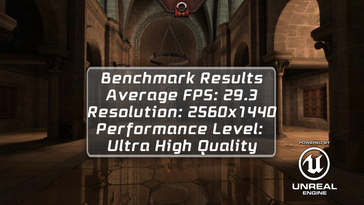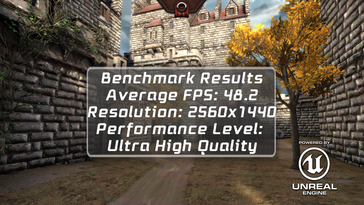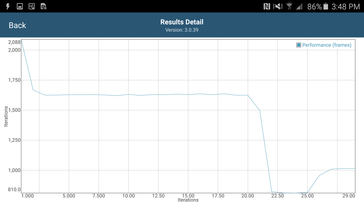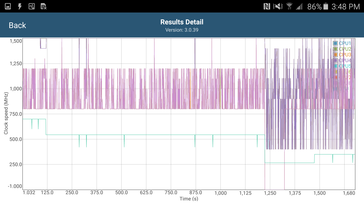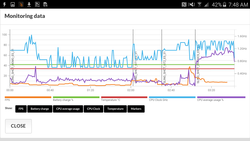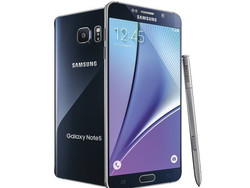Samsung Galaxy Note 5 (SM-N920A) Smartphone Review

Merge what's great about the Galaxy S6 and Galaxy Note 4 and you get the Galaxy Note 5. The hardware and specifications of the Note 5 borrow heavily from the S6 including the 2.1 GHz octa-core Exynos SoC, Mali-T760 MP8 GPU, and its 16 MP and 5 MP cameras. Meanwhile, the phablet retains a few of the best qualities of the Note series with its large 5.7-inch AMOLED 1440p display and integrated S Pen.
Some major features have been overtly omitted, however, and we'll go over exactly what's missing in this overview. Is it time to replace that Note 4 or Galaxy S6?
Case
The Note 5 manages to be thinner (7.6 mm vs. 8.5 mm), lighter (171 g vs. 176 g), and even a hair smaller in length and width than the previous Galaxy Note 4. The smartphone retains the metal edges and corners that were introduced to the series just last year as well as the always-familiar Home, Tabs, and Back buttons on the bottom. A notable change is the back cover, which is now straight-up Gorilla Glass instead of faux leather and is much more prone to fingerprints. While the change has no impact build quality, the smooth plastic-like texture is simply bland and feels more appropriate on a mainstream or cheaper smartphone than a high-end flagship device.
Twists and depressions are almost non-existent as the Note 5 is very rigid. Pressing down on the back cover, for example, shows no major gaps between it and the battery. Its smooth metal frame is a bit slippery, so a case is recommended to prevent drops from damaging the sensitive glass front.
Aside from the dull back, the Note 5 no longer uses a removable back cover. The series is still not water or dust-resistant either unlike on a handful of Sony Xperia models.
Connectivity
Some ports have been relocated to accommodate for the fixed back cover. The Nano-SIM slot is now found on the top edge and the 3.5 mm audio jack on the bottom. While OTG is still supported for plug-and-play of USB flash drives, mice, and keyboards, support for both MHL and MicroSD has been removed. The IR blaster has been axed as well and Miracast is nowhere to be found in the options.
We would have liked to see USB Type-C instead of the standard Micro-USB 2.0 port, especially from a flagship phablet on this class. Incredibly, the Note 5 has less connectivity features than its older sibling.
Software
Pre-installed Samsung software are similar to those found on the Note 4 including S Health, S Voice, and Multi Window. The latter in particular performs noticeably more smoothly on the Note 5 as we found it to be a bit clunky on the Note 4. We recommend checking out our Note 4 review for more details on the similar features.
Other features have had visual redesigns including Air Command for the S Pen, while others are completely new like Samsung Pay. The Note 5 will be one of the first devices to support the contact-less payment method as soon as it goes live.
Communication & GPS
The common GSM (850, 900, 1800, 1900 MHz) and UMTS (850, 900, 1900, 2100 MHz) bands are supported on this particular AT&T SM-N920A model. A separate model is available for Sprint users running on the CDMA network. Like the Galaxy S6, 4G LTE is supported for download and upload speeds up to 300 Mbps and 50 Mbps, respectively.
WLAN is supported on both 2.4 GHz and 5 GHz bands up to 802.11ac. At its best when just 1 meter away from our 802.11n source, a steady signal quality of around -30 dBm can be achieved. Signal drops to about -45 dBm when 10 meters from the source and finally to the -70 dBm mark when 30 meters away. A line of sight to the WLAN source is maintained throughout the test.
TTFS for the GPS is very fast even with WLAN assistance disabled. The radio has no issues maintaining a fix for extended periods without signal cutoffs. Both GLONASS and BeiDou positioning are also supported.
Telephone & Voice Quality
The Note 5 is available on all major carriers in the U.S.. It is not a dual-SIM device and will only accept Nano-SIM cards. Perhaps more importantly, the phablet supports Wi-Fi calling so both calls and texts can be made and received even if there is no tower reception. Many mainstream and high-end smartphones still lack this feature, but a SIM card is required nonetheless.
Call quality is excellent and is similar to that of the Note 4 and Galaxy S6. Our listener on the other end (LG G2) had no issues as well. Volume is loud and the speakerphone is generally clear and free of static, though voices sound more high-pitched than usual since the hardware itself is small and lacking in bass.
Cameras & Multimedia
The rear 16 MP sensor with f/1.9 aperture and front-facing 5 MP cameras should sound instantly familiar to Galaxy S6 owners as they are essentially identical. It's a slight upgrade compared to the rear 16 MP f/2.2 camera on the Note 4 where images are more likely to be overexposed due to the larger aperture.
Camera quality is one of the best for a smartphone. Images are clean and largely free from artifacts that are common on cheaper sensors such as purple fringing around dark edges, muddy dark gray colors, and noise. Moderately lit conditions still make for a good picture, though the built-in Flash is still nowhere near powerful enough for anything but macro-level shots. We recommend checking out our Galaxy S6 review for more comparison shots and details on the cameras.
On the software side, the standard auto-focus and image stabilization features deserve praise for their responsiveness and effectiveness. The latter prevents blurry photos quite well while the former is fast enough to focus on the region of interest. For day-to-day use, these are arguably some of the more important features to get right. The returning "Pro" mode and RAW picture format give advanced users shutter speed control (from 1/24000 to 10), ISO control (from 50 to 800), and manual focus. "Live Broadcast" mode is a new feature to automatically share and upload videos on YouTube.
Accessories & Warranty
Included extras are the usual AC adapter, Micro-USB cable, and earphones. Purchasing the device off-contract from AT&T will net users a nano-SIM card as well. Official optional accessories include a Qi quick-charging wireless pad, clear and wallet-type protective covers, and even a physical QWERTY keyboard add-on.
Limited warranty is the usual one-year period from date of purchase.
Input Devices & Handling
Touchscreen
The 10-point Gorilla Glass 4 touchscreen handles as expected. That is, the capacitive display is as responsive and accurate around edges and corners as it is towards the center. It's also quite sensitive as even the lightest of taps are registered precisely and almost instantly when texting. The differences are noticeable when compared to budget-grade smartphones where inputs are missed much more frequently.
Keyboard layout is essentially identical to that of the Galaxy S6 with Swype-like support already built-in. Our original Note 4 reviewer mentions that the layout in Landscape mode does not fully utilize the length of the screen size. This is likely intentional to prevent cramped thumbs as tapping on the outer edge of the display is more difficult for larger hands.
As for the fingerprint sensor, it works reasonably well for recognizing the user and for unlocking the device. The sensor will fail if the user taps too quickly or lightly, and tapping with the finger at an angle can throw off the sensor as well. We would like for it to work a bit more quickly for future revisions.
S Pen
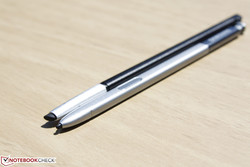
The S Pen returns with a push-button release-and-lock that should feel instantly familiar to anyone who has ever used a retractable ballpoint pen. The mechanism itself works smoothly, though users with larger hands and short nails may find it more difficult to retract the active stylus without first fumbling around.
Other than the unique push-button feature, the S Pen performs similarly to its Note 4 counterpart. The button on the stylus continues to be very handy for copying and pasting and can be customized to quickly launch applications. Its length (~11.5 cm), however, is quite short and its thin form factor makes it uncomfortable to use for long periods. Fast note-takers will still notice a delay time between the moment the pen is moving and the when a mark is actually shown onscreen. Additionally, users who are normally light hand-writers may want to apply more pressure with the S Pen as the display will sometimes not register light inputs during this mode.
There have been user complaints about owners unintentionally damaging the Note 5 by inserting the S Pen backwards. In our tests, the stylus fits in its recess with no issues when right-side up (with the Samsung logo facing up) or even upside-down (with the Samsung logo facing down) so long as the sharp end enters first. Thus, any potential damage can be very easily avoided.
Display
Users will have a hard time noticing any major differences between the displays of the Note 4 and Note 5. Both devices make use of a 5.7-inch Super AMOLED 2560 x 1440 resolution display that already bests most phablets currently in the market in accuracy and contrast. Instead of increasing screen size or resolution even further, Samsung has upped the maximum brightness for its newest model to almost 400 nits compared to roughly 330 nits on the outgoing model. Nonetheless, a handful of flagship smartphones still come in brighter including the iPhone 6 Plus, HTC One M9, and the Sony Xperia Z3.
| |||||||||||||||||||||||||
Brightness Distribution: 91 %
Center on Battery: 394.8 cd/m²
Contrast: ∞:1 (Black: 0 cd/m²)
ΔE ColorChecker Calman: 1.49 | ∀{0.5-29.43 Ø4.78}
ΔE Greyscale Calman: 1.98 | ∀{0.09-98 Ø5}
Gamma: 2.19
CCT: 6382 K
| Samsung Galaxy Note 5 SM-N920A | Apple iPhone 6 Plus | Google Nexus 6 | Samsung Galaxy Note 4 | LG G Flex 2 | HTC One M9 | |
|---|---|---|---|---|---|---|
| Screen | -36% | -108% | -10% | -146% | -103% | |
| Brightness middle (cd/m²) | 394.8 | 519 31% | 274 -31% | 335 -15% | 278 -30% | 474 20% |
| Brightness (cd/m²) | 397 | 496 25% | 264 -34% | 339 -15% | 274 -31% | 458 15% |
| Brightness Distribution (%) | 91 | 90 -1% | 89 -2% | 92 1% | 97 7% | 85 -7% |
| Black Level * (cd/m²) | 0.62 | 0.4 | ||||
| Colorchecker dE 2000 * | 1.49 | 3.67 -146% | 6.99 -369% | 1.77 -19% | 8.03 -439% | 6.32 -324% |
| Greyscale dE 2000 * | 1.98 | 3.78 -91% | 4.01 -103% | 2.06 -4% | 6.71 -239% | 6.36 -221% |
| Gamma | 2.19 100% | 2.42 91% | 2.03 108% | 2.41 91% | 1.89 116% | 2.43 91% |
| CCT | 6382 102% | 7327 89% | 6329 103% | 6424 101% | 7750 84% | 8218 79% |
| Contrast (:1) | 837 | 1185 | ||||
| Color Space (Percent of AdobeRGB 1998) (%) | 99 | 58.81 |
* ... smaller is better
DisplayMate recently crowned the Galaxy Note 5 for having the best display of any smartphone currently in the market. Our own tests with an X-Rite spectrophotometer only bolsters the claim as the Note 5 carries some of the lowest grayscale and color deviation values in our database. Gamma is almost perfect at 2.2 and colors are indeed much more accurate than other flagships in the market. Combine this with the wide color space and an essentially perfect contrast and you have a display that's worthy of the title "Best smartphone display available".
Like most other Samsung smartphones, the Note 5 includes other color modes such as Cinema and Photo. Cinema mode in particular brightens colors considerably to make videos and images pop. While this mode may be perfect for brick and mortar stores, home users should stick with Basic mode for the most accurate colors and grayscale.
Outdoor usability is even better than the Note 4 due to the brighter backlight. texts and images can be seen comfortably when working under shade so long as glare can be avoided. The screen becomes more washed out when working under direct sunlight.
With that said, the Note 5 shares another unique feature alongside the Note 4 and newer Galaxy devices: Enabling the ambient light sensor will allow the backlight to become brighter than the maximum manual brightness setting. We measured a maximum display brightness of 550 nits with an LED flashlight placed right above the sensor. Thus, users are encouraged to enable the feature when working outdoors.
Viewing angles are very wide as expected from a Super AMOLED panel. Users will notice a slight rainbow effect if viewing from abnormally obtuse angles, though this is insignificant during regular use.
Performance
Samsung has ousted the Snapdragon 805 on the Note 4 for its own in-house 14 nm Exynos 7420 SoC as found on the Galaxy S6. Thus, raw performance is essentially on par with the Galaxy S6 and we recommend checking out our full page for additional comments and benchmarks on the processor.
Four of the eight Exynos 7420 cores are high-performance cores capable of speeds up to 2.1 GHz, while the last four are more power-efficient cores up to 1.5 GHz. When the system is idle, these processors will run at just 400 MHz and 800 MHz, respectively, according to CPU-Z.
Smartphone-based benchmarks have always been less consistent compared to benchmarks designed for Windows PCs. As a result, hard numbers are generally a poorer indication of performance when comparing smartphones for day-to-day use. Nonetheless, our Note 5 scores highly on AnTuTu at 20 percent over the Note 4, though scores on AnTuTu and Geekbench are lower than the Galaxy S6 despite having the same processor.
4 GB of system RAM should be more than enough for everyday needs and should be especially handy for Multi Window mode. Free RAM is of course much lower at just ~1.9 GB immediately after bootup.
| AnTuTu v5 - Total Score (sort by value) | |
| Samsung Galaxy Note 5 SM-N920A | |
| Samsung Galaxy S6 | |
| HTC One M9 | |
| Google Nexus 6 | |
| Apple iPhone 6 Plus | |
| LG G4 | |
| OnePlus One | |
| Samsung Galaxy Note 4 | |
| Geekbench 3 | |
| 32 Bit Multi-Core Score (sort by value) | |
| Samsung Galaxy S6 | |
| HTC One M9 | |
| Google Nexus 6 | |
| Apple iPhone 6 Plus | |
| LG G4 | |
| OnePlus One | |
| Samsung Galaxy Note 4 | |
| 32 Bit Single-Core Score (sort by value) | |
| Samsung Galaxy S6 | |
| HTC One M9 | |
| Google Nexus 6 | |
| Apple iPhone 6 Plus | |
| LG G4 | |
| OnePlus One | |
| Samsung Galaxy Note 4 | |
| 64 Bit Multi-Core Score (sort by value) | |
| Samsung Galaxy Note 5 SM-N920A | |
| HTC One M9 | |
| LG G4 | |
| 64 Bit Single-Core Score (sort by value) | |
| Samsung Galaxy Note 5 SM-N920A | |
| HTC One M9 | |
| LG G4 | |
| GFXBench 3.0 | |
| on screen Manhattan Onscreen OGL (sort by value) | |
| Samsung Galaxy Note 5 SM-N920A | |
| Samsung Galaxy S6 | |
| HTC One M9 | |
| Google Nexus 6 | |
| Apple iPhone 6 Plus | |
| LG G4 | |
| OnePlus One | |
| Samsung Galaxy Note 4 | |
| 1920x1080 1080p Manhattan Offscreen (sort by value) | |
| Samsung Galaxy Note 5 SM-N920A | |
| Samsung Galaxy S6 | |
| HTC One M9 | |
| Google Nexus 6 | |
| Apple iPhone 6 Plus | |
| LG G4 | |
| OnePlus One | |
| Samsung Galaxy Note 4 | |
Browser-based benchmarks like Octane, Sunspider, and Browsermark score the Note 5 very well compared to the Note 4. its Sunspider score, however, is still no match for the iPhone and its Safari browser.
| Octane V2 - Total Score (sort by value) | |
| Samsung Galaxy Note 5 SM-N920A | |
| Samsung Galaxy S6 | |
| LG G4 | |
| Apple iPhone 6 Plus | |
| HTC One M9 | |
| Google Nexus 6 | |
| Samsung Galaxy Note 4 | |
| Browsermark - 2.1 (sort by value) | |
| Samsung Galaxy Note 5 SM-N920A | |
| Samsung Galaxy S6 | |
| LG G4 | |
| HTC One M9 | |
| OnePlus One | |
| Samsung Galaxy Note 4 | |
* ... smaller is better
Having no MicroSD support is one thing, but to take away MicroSD support when users were expecting otherwise is even worse. This is exactly the case when moving from the Note 4 to the Note 5.
Fortunately, Samsung has improved the performance of the internal SSD substantially over the original Note 4 according to AndroBench 3. Sequential read and write rates are over twice and even thrice that of the Note 4. The storage medium is identical to the one in Galaxy S6, so theoretical performance is very similar.
Gaming Performance
All tested games from the Play market run smoothly on our Note 5. The powerful GPU is bested only by the likes of the high-end Tegra K1, Adreno 430, and Apple A8X according to raw GPU benchmarks. See our dedicated GPU page for more technical information and benchmarks on the Mali-T760 MP8.
More intensive graphics benchmarks like Lightmark show that there is still plenty of room for improvement. Extreme throttling on the Note 5 can drop GPU performance as shown in our Epic Citadel test. This can also be reproduced by running the GFXBench 3.0 Battery Test, which loops an intensive graphics benchmark dozens of times in succession to observe for any throttling or stability issues. Throttling of both the CPU and GPU occur about 20 minutes into the test. In fact, we had to rerun some benchmarks on a cold state as running different benchmarks one after another would eventually cause final scores to be lower than expected from a smartphone of this class.
| Epic Citadel - Ultra High Quality (sort by value) | |
| Samsung Galaxy Note 5 SM-N920A | |
| HTC One M9 | |
| OnePlus One | |
| LG G Flex 2 | |
| LG G4 | |
| Lightmark - 1920x1080 1080p (sort by value) | |
| Samsung Galaxy Note 5 SM-N920A | |
| HTC One M9 | |
| OnePlus One | |
| LG G Flex 2 | |
| LG G4 | |
| 3DMark | |
| 2560x1440 Sling Shot Extreme (ES 3.1) Physics (sort by value) | |
| Samsung Galaxy Note 5 SM-N920A | |
| HTC One M9 | |
| Samsung Galaxy S6 | |
| LG G4 | |
| 2560x1440 Sling Shot Extreme (ES 3.1) Graphics (sort by value) | |
| Samsung Galaxy Note 5 SM-N920A | |
| HTC One M9 | |
| Samsung Galaxy S6 | |
| LG G4 | |
| 2560x1440 Sling Shot Extreme (ES 3.1) (sort by value) | |
| Samsung Galaxy Note 5 SM-N920A | |
| HTC One M9 | |
| Samsung Galaxy S6 | |
| LG G4 | |
| 2560x1440 Sling Shot OpenGL ES 3.0 Physics (sort by value) | |
| Samsung Galaxy Note 5 SM-N920A | |
| HTC One M9 | |
| Samsung Galaxy S6 | |
| LG G4 | |
| 2560x1440 Sling Shot OpenGL ES 3.0 Graphics (sort by value) | |
| Samsung Galaxy Note 5 SM-N920A | |
| HTC One M9 | |
| Samsung Galaxy S6 | |
| LG G4 | |
| 2560x1440 Sling Shot OpenGL ES 3.0 (sort by value) | |
| Samsung Galaxy Note 5 SM-N920A | |
| HTC One M9 | |
| Samsung Galaxy S6 | |
| LG G4 | |
Emissions
Temperature
Surface temperatures when idling are warm at about 31 C on both sides of the device. This is noticeably warmer than the Note 4, which average about 27 C at roughly the same ambient room temperature.
Running high loads for extended periods will bring temperatures up to about 34 to 35 C on both sides of the Note 5. This is just slightly cooler than the Note 4 under similar conditions, yet is much warmer than the thinner Galaxy S6. Smartphones with Snapdragon SoCs tend to be even warmer, such as the Nexus 6 and Nokia Lumia 1520. As is typical for most smartphones, the top half of the device will become much warmer than the bottom half since the battery is normally situated beneath the motherboard.
(+) The maximum temperature on the upper side is 36.4 °C / 98 F, compared to the average of 35.2 °C / 95 F, ranging from 21.9 to 247 °C for the class Smartphone.
(+) The bottom heats up to a maximum of 37.4 °C / 99 F, compared to the average of 34 °C / 93 F
(+) In idle usage, the average temperature for the upper side is 31.9 °C / 89 F, compared to the device average of 32.9 °C / 91 F.
Speakers
The mono speaker has been relocated from the rear of the device to the bottom edge, similar to the Galaxy S6.
Sound quality has not improved over the Note 4. Music lack bass and feel weak even for a smartphone. Nonetheless, sounds are clear and have no distortions on higher volume settings.
Battery Life
Battery capacity is down compared to the Galaxy Note 4 (3220 mAh vs. 3000 mAh), but runtimes appear almost identical nonetheless. Its WiFi runtime of just over 7 hours of constant use should be enough for most users. Turning up the brightness will drop battery life, but not significantly so. Enabling the Power Saver mode to limit CPU performance may push WiFi runtimes even longer.
At its best, we were able to record an idling runtime of over 29 hours. This involves setting the phone to Power Saver mode at minimum display brightness and idling on the Home screen until automatic shutdown.
Note that our WiFi v1.3 and original WiFi v1.0 tests are not directly comparable as our latest version is more intensive and a better representation of real-world browser use.
| Samsung Galaxy Note 5 SM-N920A 3000 mAh | Apple iPhone 6 Plus 2915 mAh | Google Nexus 6 3220 mAh | Samsung Galaxy Note 4 3220 mAh | LG G Flex 2 3000 mAh | HTC One M9 2840 mAh | |
|---|---|---|---|---|---|---|
| Battery runtime | -29% | -46% | -3% | -12% | -34% | |
| Reader / Idle (h) | 29.6 | 23.9 -19% | 19.2 -35% | 27.8 -6% | 21.2 -28% | 13.4 -55% |
| WiFi v1.3 (h) | 7.2 | 10.7 49% | 5.8 -19% | |||
| Load (h) | 5.4 | 3.3 -39% | 2.3 -57% | 5.4 0% | 2.4 -56% | 3.9 -28% |
| WiFi (h) | 13 | 10 | 12.4 | 9.6 |
Pros
Cons
Verdict
Is the Galaxy Note 5 worth the upgrade if you already have a Note 4 or Galaxy S6? The push-button S Pen is genuinely ergonomic and more than just a novelty feature, while the brighter and more accurate display will easily draw in enthusiasts. For existing Note 4 owners, however, the Note 5 feels more like a sidestep than an upgrade since it takes away almost as many features (MHL, IR blaster, removable battery, MicroSD) as it adds (Fingerprint reader, push-button S Pen, improved display, thinner design). Meanwhile, S6 owners would simply be moving onto a larger display with essentially identical internal hardware. A more appropriate name for this model would have been the "Galaxy Note S6" as it doesn't feel like a true leap forward compared to the excellent Note 4.
For everyone else, the Galaxy Note 5 is worth a closer hands-on test. Its S Pen in particular will make or break the deal as some users may find it incredibly useful for their daily tasks, while others may find the pen to be too small to comfortably hold for extended periods. This reviewer falls in the latter camp, but the dazzling display and promising S Pen features shouldn't be overlooked, either.
It's an impressive device so long as buyers are aware of what exactly the Note 5 is lacking compared to its predecessor.
Samsung Galaxy Note 5 SM-N920A
- 04/18/2016 v5 (old)
Allen Ngo




